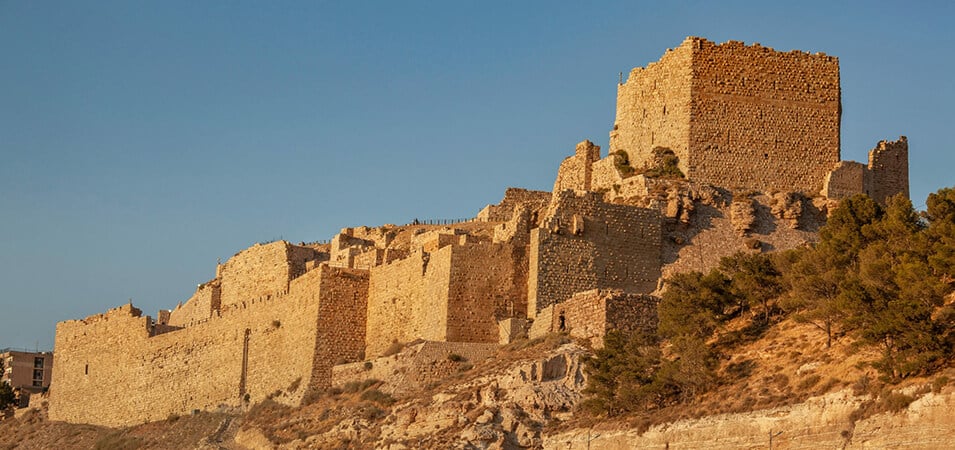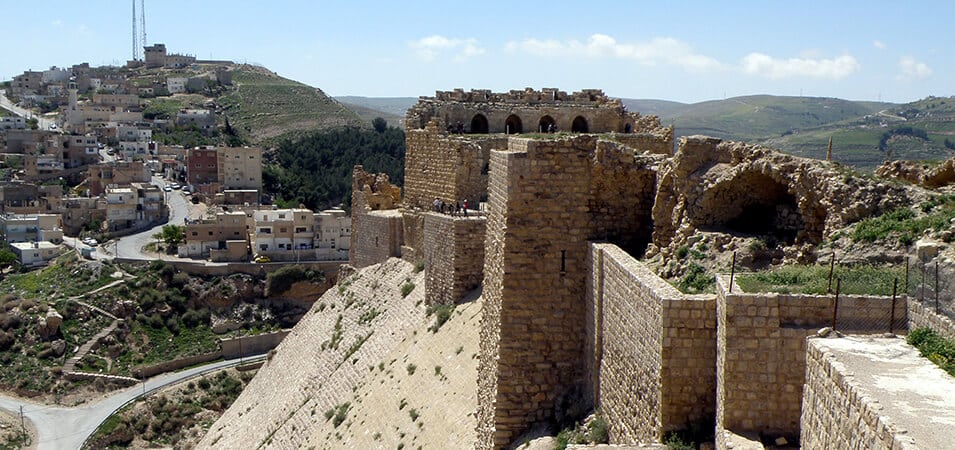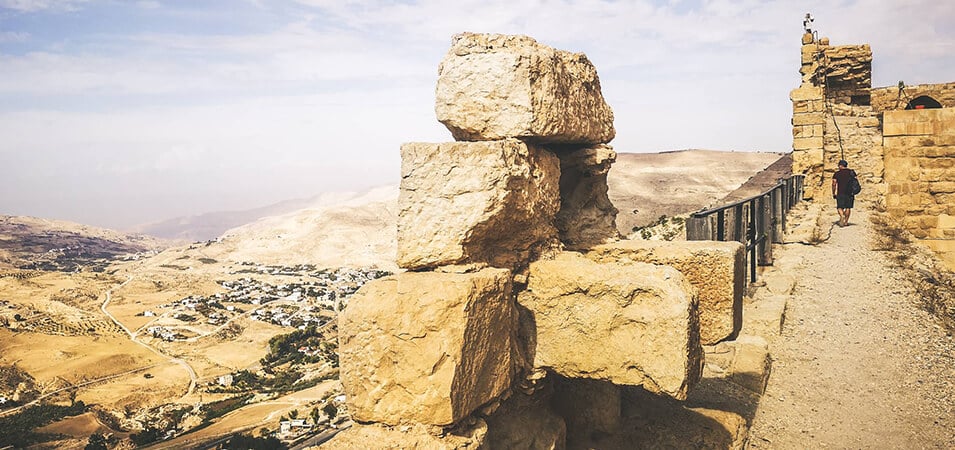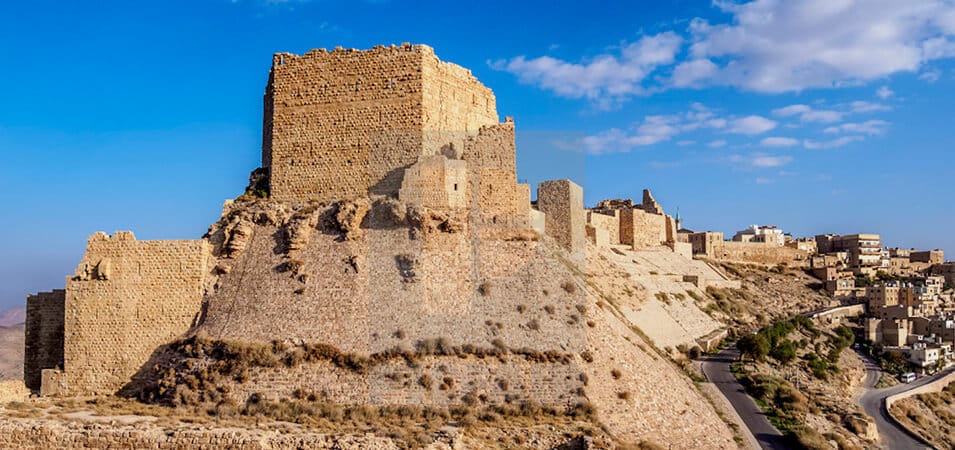Nestled on a rugged hilltop in the heart of Jordan, Kerak Castle is a testament to the region’s rich historical legacy. The castle’s imposing presence and remarkable architecture have captivated visitors worldwide. This article aims to delve into the depths of Kerak Castle’s allure by exploring its history, architectural marvels, cultural significance, and practical information for visitors.
Don’t Miss checking out our Jordan Travel Packages.
Name Meaning of Kerak Castle

The name “Kerak” is derived from the ancient Aramaic word “Karra,” meaning “fortress” or “castle.” It aptly describes the nature and purpose of this historical landmark. Kerak Castle, also known as Crusader Castle or Al-Karak, is a formidable fortress, symbolizing strength and strategic importance.
The name encapsulates the essence of the castle’s role throughout history as a stronghold and defensive bastion. It evokes a sense of power and resilience, reflecting the architectural grandeur and historical significance of Kerak Castle. Today, Kerak has become synonymous with this iconic fortress, attracting visitors worldwide to explore its rich heritage and experience its captivating allure.
Significance of The Castle as a Historical Landmark
Kerak Castle is a historical landmark, representing the convergence of different civilizations and the region’s ebb and flow of power. Its strategic location, perched atop a cliff overlooking the magnificent valleys and trade routes, allowed it to serve as a critical stronghold throughout history.
Origins and History of Kerak Castle

The foundations of Kerak Castle were laid in the 12th century, during the Crusader period. Built upon earlier Byzantine and Roman fortifications, the castle was commissioned by Pagan the Butler, a nobleman of the Crusader Kingdom of Jerusalem.
Skilled masons and craftsmen brought the castle to life, combining Crusader and Arabic architectural techniques.
Over the centuries, Kerak Castle witnessed a series of power struggles and changing hands between various factions. Initially constructed by Crusaders, it eventually fell under the control of Muslim forces, most notably the Ayyubids and the Mamluks. The castle played a crucial role in defending against invasions, controlling trade routes, and exerting regional influence.
Architecture and Design of The Castle
Kerak Castle’s architecture showcases a harmonious blend of defensive fortifications and functional living spaces. The castle is divided into distinct sections, each serving a specific purpose. Its strategic layout allowed for effective defense and facilitated communication within the castle walls.
One of the most intriguing aspects of Kerak Castle is its formidable defensive features. The thick stone walls, fortified towers, and arrow slits demonstrate the castle’s robustness and strategic positioning. From its elevated vantage point, the castle offered commanding views of the surrounding landscape, enabling its occupants to monitor and control movement in the region.
Kerak Castle’s architectural details captivate visitors with their intricacy and craftsmanship. Ornate carvings, decorative motifs, and beautifully arched doorways showcase the skill and artistic sensibilities of the castle’s builders. Delving deeper into the castle’s corridors reveals hidden chambers, underground passageways, and an underground cistern, all testaments to the ingenuity of its architects.
Description of the Kerak Castle

Grand Entrance and Gatehouse:
The grand entrance and gatehouse of Kerak Castle leave a lasting impression on all who pass through them. Towering above visitors, the gatehouse is an architectural masterpiece, complete with a drawbridge, portcullis, and murder holes. Walking through the gate transports visitors back in time, immersing them in the castle’s storied past.
Courtyards and Inner Chambers in the Castle:
The castle’s courtyards and inner chambers offer a glimpse into the daily life of its inhabitants. Exploring these spaces unveils remnants of kitchens, storerooms, living quarters, and a small mosque. The courtyard’s peaceful ambiance invites visitors to reflect upon the castle’s vibrant history.
Kerak Castle Towers and Watchtowers
Kerak Castle has towers and watchtowers, providing panoramic views of the surrounding landscapes. Climbing these towers offers visitors breathtaking vistas, stretching from the undulating hills to the distant horizons. One can truly appreciate the castle’s strategic positioning from these vantage points.
Underground Passageways and Tunnels
A maze of underground passageways and tunnels lies beneath Kerak Castle, shrouded in mystery and intrigue. These tunnels served multiple purposes, including communication, storage, and escape routes during the conflict. Venturing through these dimly lit pathways, visitors can feel the echoes of the past reverberating through the stone walls.
Historical Significance of Kerak Castle
Kerak Castle played a pivotal role in shaping the regional politics and conflicts of the Levant. Its strategic location on the trade routes linking Egypt, Syria, and Arabia made it a coveted prize for considerable powers throughout history. The castle’s control over these vital routes allowed its owners to influence and dominate regional politics.
Throughout its history, Kerak Castle witnessed several notable events and battles that left an indelible mark on the region. From the Crusader-Saracen conflicts to the clashes between different Muslim dynasties, the castle stood as a resilient bastion, holding steadfast against the tides of conquest.
The influence of various civilizations can be traced within the walls of Kerak Castle. The Crusaders left their mark through their distinct architectural style and military strategies. Subsequent Muslim rulers contributed to the castle’s transformation, incorporating their architectural flourishes and adapting the castle to their needs.

Cultural Significance of The Castle
The castle holds immense cultural significance for the local population, serving as a tangible link to their ancestors and a symbol of resilience. Its towering presence evokes a sense of pride and identity among the people, reminding them of the region’s rich historical tapestry.
Kerak Castle has become a tourist magnet, drawn to its historical allure and architectural marvels. Its preservation and restoration efforts have ensured that future generations can witness and appreciate the castle’s grandeur, fostering an appreciation for cultural heritage and contributing to the local economy.
Efforts to Restore and Preserve Kerak Castle
Recognizing the importance of Castle as a historical gem, diligent restoration and conservation efforts have been undertaken to safeguard its legacy. Skilled professionals, archaeologists, and conservators have collaborated to stabilize structures, repair damage, and maintain the castle’s authenticity.
Preserving Kerak Castle presents numerous challenges, including the harsh climatic conditions and the inherent structural complexities. However, despite these obstacles, significant achievements have been made in conserving the castle’s architectural integrity and ensuring its long-term survival.

Safety Tips and Guidelines for The Castle Visitors :
- Wear comfortable clothing and sturdy shoes for walking and exploring the castle’s terrain.
- Apply sunscreen, wear a hat, and wear sunglasses to protect yourself from sun rays, as Kerak Castle offers limited shade.
- Bring a water bottle and stay hydrated throughout your visit, especially during the hot summer months.
- Respect any signs, barriers, or instructions provided by the castle authorities. Some areas may be restricted for safety or preservation purposes.
- Be cautious while walking through the castle, as the terrain may be uneven, and there might be steps and low doorways.
- Kerak Castle is a historical site, so treat it with respect. Do not climb on or touch fragile structures, artifacts, or walls.
- Keep your personal belongings secure at all times. Avoid carrying large amounts of cash or valuable items.
- If visiting with a guided tour, stay with the group and follow the guide’s instructions.
- Familiarize yourself with emergency exits and evacuation procedures. In case of any emergency, follow the guidance of the castle staff.
- Respect the experience of fellow visitors by maintaining a peaceful and considerate attitude.
Don’t Miss to Check out our Related Article :
